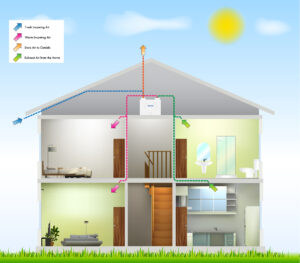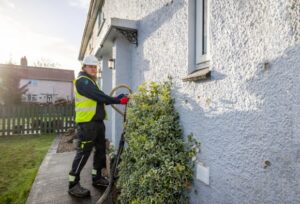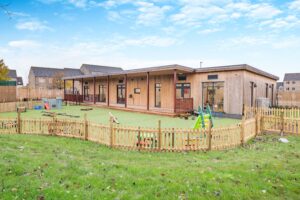Ronnie George, is CEO of Volution
We may be forgiven for not thinking about the air we breathe when we are in the comfort of our own home however this is to our detriment. While we may not see it, indoor air quality has an outsized impact on our wellbeing and major societal and economic repercussions.
Short-term health effects include irritation of the eyes, nose and throat, headaches, dizziness and fatigue. Longer-term consequences can include respiratory diseases, heart disease and cancer. Researchers at the University of Oxford’s Department of Psychiatry have found evidence that exposure to air pollutants may lead to depression, anxiety, psychoses and possibly even neurocognitive disorders.

The system is extracting humid stale air from the bathroom and kitchen and passing it through a heat exchanger before it is exhausted outside. Fresh air is then brought into the house, through the heat exchanger, to recover up to 94% of the heat, then introducing that fresh and tempered air into the bedroom and living areas of the house. This ensures the whole property is ventilated continuously without losing any heat.
There is no mortality statistic for the UK however the World Health Organization states 3.8 million premature deaths worldwide are linked to poor indoor air every year out (with another 4.9 million due to general air pollution).
Indoor air can be up to 50 times more polluted than outdoor air due to the myriad pollutants we’ve invited into our home – including Volatile Organic Compounds (VOCs), found in many products such as everyday cleaning supplies, carpets, paints and air fresheners; carbon monoxide and nitrogen dioxide from our gas stoves; tobacco smoke; dust mites that live in our bedding and other soft furnishings; building and insulation materials such as synthetic mineral fibres, asbestos and formaldehyde; and mould.
This is worsened by the recent but much-needed trend to insulate buildings. Heating and powering buildings accounts for 30% of the UK’s total energy usage therefore reducing the built environment’s carbon footprint is integral to the UK’s Net Zero agenda. Key to constructing buildings that are more energy efficient and have significantly fewer emissions is insulation. The conundrum here though is the better insulated a building is, the more ventilation it needs because more pollutants are trapped.
Poor indoor air quality can be found in all forms of buildings however sub-standard housing intensifies the harm. A report from Shelter shows children living in sub-standard housing in the UK have up to a 25% higher risk of severe ill health and disability during childhood and early adulthood, lower educational attainment and greater likelihood of unemployment and poverty. To put the issue in financial terms, poor-quality housing in the UK leads to an additional £1.4 billion spent by the NHS each year.
By contrast, energy efficiency, combined with effective ventilation, is associated with reduced morbidities such as asthma and eczema and reduced blood pressure, sinusitis and chronic obstructive pulmonary disease. Putting it in financial terms, according to the Royal Academy of Engineering, £1.3 trillion over a 60-year period could be unlocked by ensuring buildings are fully infection resilient via ventilation.
As we learned during the pandemic, ventilation is key to keeping healthy. However not all ventilation systems are equal and not all of them are up for the task of ventilating the new generation of well-insulated buildings. There are three main technologies, all ventilation continuously, which provide the best contemporary solutions.
MVHR (Mechanical Ventilation with Heat Recovery) is a whole dwelling, ventilation system delivering warmed, fresh and filtered air to the habitable rooms whilst reducing energy use and costs by recovering the heat from the stale extracted air. This is best suited to either new build or deeply renovated properties and more and more new houses are being fitted out with MVHRs however, at 30%, it’s still a minority.
MEV (Mechanical Extract Ventilation) is a whole dwelling ventilation system that extracts air continuously at a low rate. It is a low-energy, continuously running ventilation system designed with multiple extract points to simultaneously draw moisture-laden air out of all the wet rooms of a dwelling (bathrooms and kitchen) providing a quieter and more energy-efficient system compared to separate intermittent extract fans. This works well in renovation where existing exhaust fans can be easily replaced to upgrade the ventilation system.
PIV (Positive Input Ventilation) is an energy-efficient method of pushing out and replacing stale, unhealthy air by gently pressurising the home with fresh, filtered air to increase the overall circulation of air in the dwelling. This is ideal for refurbishment where there are no extract fans previously fitted and can be very quick and easy to install.

We have the tools to ensure buildings are well insulated however we are still far away from ensuring healthy indoor air for all.
To date, there has been research by government and non-government groups, academia and corporates however it’s just not enough. Indoor air isn’t a behemoth – the way pollutants interact with each other differs depending on the type of ventilation used, who are the occupants and how the building was constructed. Therefore all of these factors must be studied in different combinations so we can come up with the best solutions.
Optional initiatives for landlords, builders and tenants will not be enough to guarantee UK residents are safe in their own homes. What we need is a top-down approach that mandates the necessary level of ventilation – ideally continuous mechanical ventilation – for indoor safety and comfort.
The Decent Homes Standard, which is out for consultation, covers a set of standards across the rental sector. Currently, it does not specifically talk to or mandate ventilation. This is misguided as ventilation is integral to both quality of life and a decarbonised building stock. The better way forward would be mandatory requirement for ventilation in line with the minimum requirements of Approved Document Part F (ADF) of Schedule 1 to the Building Regulations and in a number of specific building regulations. This is the only way to guarantee both new and old buildings meet the same standards.
The Ministry of Housing, Communities and Local Government published ADF, which took effect in 2022 and requires that adequate ventilation is provided to guard against internal moisture build-up. Approved Document L (ADL) sets energy performance standards for new and existing buildings and has been modified to move away from intermittent extract fans to high-performing continuous extract fans and whole dwelling heat recovery systems.
Both ADF and ADL are due out for consultation later this year as part of the Future Home Standards from 2025, which has the aim of making all new homes built from 2025 emit 75-80% less carbon than homes built under the current Building Regulations. This is a step in the right direction but to maximise impact, ADF and ADL should be developed together.
Moreover, what is key from Part L is an upgrade of the carbon reduction calculation SAP (SAP11), which sets the energy performance target each building must achieve. Crucially, the Government, through Part L, should ensure that SAP mandates mechanical heat recovery ventilation as the standard for new builds. It is by far the most efficient form of ventilation and, without it, Net Zero will not happen.
At the same time, the current version of SAP used for existing homes (RDSAP), now many years old, is no longer fit for purpose as it does not integrate modern ventilation equipment and heat recovery as part of a building’s carbon reduction strategy.
Then there is Awaab’s Law, driven by the tragic death of two-year-old Awaab Ishak. Awaab’s death, a completely preventable tragedy caused by the damp and mould in his home. This new amendment to the Social Housing Regulation Bill is important because it will crackdown on damp and mould and force landlords to investigate and fix serious problems within strict time limits.
While the biggest impact to our health would come from top-down Government regulation, I would also like to see more grassroots education targeting the general public. There is currently an All-Party Parliamentary Group (APPG) for Healthy Homes and Buildings and there are some non-profits, such as Shelter, which are educating the general population about the risks of poor air quality. It is not enough though. The APPG must be strengthened and there must be more communication and education.
Lastly, the Government needs to put more funding directed towards buildings. Currently, only 1% of buildings in Europe are being renovated on a yearly basis but to hit our Net Zero target by 2050, we need to increase it to 3% per year. This will require Government support. The Social Housing Decarbonisation Fund is helping, but without a fit for purpose RdSAP, the right decisions may not be made.
We all have the ability to make decisions in our best interests however sometimes the stakes are too high. Just like seatbelts or smoke alarms, continuous mechanical ventilation must be mandated by the Government for both new and old buildings. It not only will keep us safe but will be fundamental in the fight against carbon emissions.
This article originally appeared in issue 22 of Air Quality News















